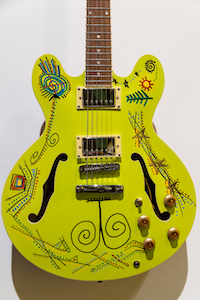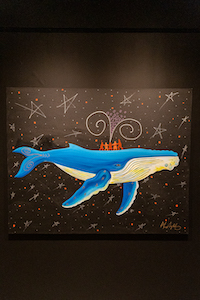As you enter the Dalhousie Art Gallery’s current exhibition, the spirit of Alan Syliboy’s work hits you immediately. Drums echo and vibrant images dance across walls in the form of portraits, painted instruments, and a larger-than-life mural of a great horned serpent. The emotional response is immediate.
Syliboy was born and raised on Millbrook First Nation, and his career as an artist is more than 50 years in the making. Syliboy’s exhibit is a celebration of Mi’kmaq culture, spirituality, and friendship, drawing on a multitude of work from private collectors and friends. Many of the pieces focus on Indigenous petroglyphs, a form of rock carvings made by his ancestors.
The Dalhousie Art Gallery commissioned Syliboy to paint a mural as part of the 50-year retrospective on his life’s work. It took two weeks to bring the vision of the mural to life with the help of his grandchildren and others. Gallery Director and Curator Pamela Edmonds wanted the piece to guide the story of Syliboy’s work with petroglyphs full circle.
“I was seeing the wall as both large petroglyph and an expansive canvas,” explains Edmonds. “As his ancestors were writing on rocks. I didn’t want him to just have art objects in the gallery, but to be able to expand his vision for the space. The work started with the idea of creating an image of jipijka'm based on this mystical animal, a great horned serpent.”
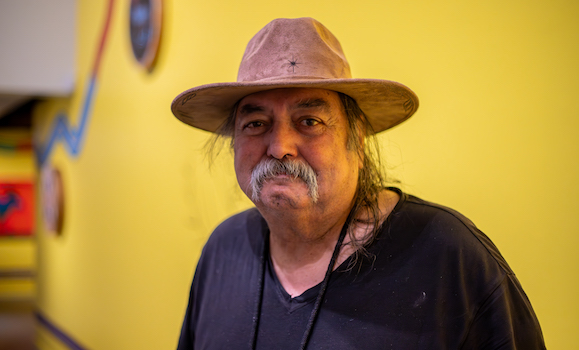
Artist Alan Syliboy.
The mural is the first thing you see as you enter the gallery. It extends far across the top of the wall and wraps around a small alcove filled with more of Syliboy’s artwork. But as you dig into the exhibit, you’ll also find smaller visual connections back to his family and his artistic roots. One highlight is an early painting of two figures on a dark nature-inspired background of shadow and light. The painting was rendered in 1975 and brilliantly captures the early essence of Syliboy’s work with petroglyphs. The figures speak to you in silence, evoking a sense of wonder and curiosity.
Throughout, you’ll hear music from his band, Alan Syliboy and The Thundermakers, where he plays percussion and also performs spoken word as well. One exhibit room is dedicated to music and vibrant sketches, showing some of Alan’s drums and a hand-painted guitar belonging to his son.
“He was telling me this is an improvised song about how he works on his art, how he discovered the petroglyphs,” says Edmonds as she gestures to lyrics written on a wall called “Marks on the Ground.” “He heard voices from his ancestors and understands culture as medicine, and remembering stories that were lost after contact with Europeans.”
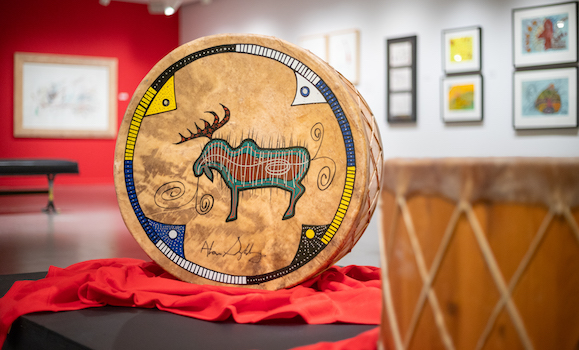
Drum painted by Syliboy.
The exhibit also includes animation, music videos and an homage to long-time friend and collector, Marcia Hennessy. Marcia was one of the main inspirations for the retrospective. She amassed more than 100 unique pieces of Syliboy’s work in her lifetime.
“The show really started because of an idea that came from Alan about finding a way to honour her support of her work. Marcia was based in upstate New York, saw Alan's work at an exhibition in Toronto, and just fell in love with it,” says Edmonds. “She contacted Alan, and they maintained a friendship and corresponded for over 30 years,” Pamela explains.
Gallery visitors can read some of the correspondence she and Syliboy sent to each other during the course of their friendship and view an assortment of Syliboy’s artwork from her private collection. The difference between these pieces and the larger paintings near the mural is striking.
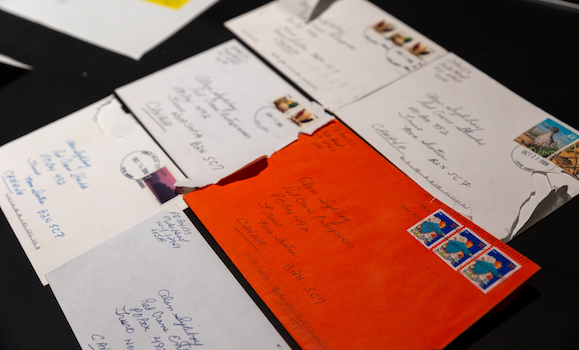
Letters and correspondence.
“He wanted to celebrate his collectors and supports as well,” Edmonds says. “It sort of shows the gratitude that Alan has for people that have supported him. It's not about just seeing art as an investment. It's also about supporting the culture. It's like a spiritual and creative community in this space.”
Syliboy is also the co-creator of the New Dawn Staff of Place and Belonging, used as part Dal convocation ceremonies. While the staff isn’t present in the exhibit, it’s worth pointing out the impact Syliboy’s art has had within the Dalhousie community, not only through this exhibit, but his contribution to graduates.
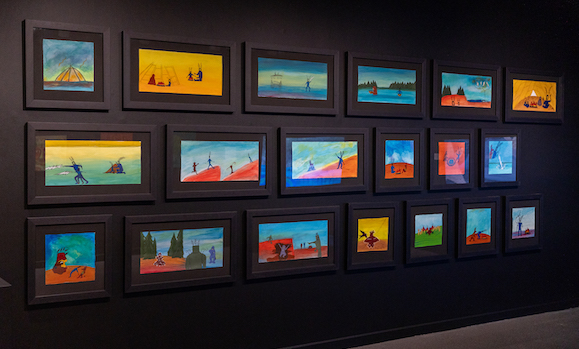
A series of painitings from the exhibit.
“I think sometimes we get kind of stuck on this idea of what art should be or look like,” says Edmonds. “I want the gallery to be a welcoming space to every community, that we show the diversity of not just the campus, but people that traditionally may have not been as visible in terms of cultural representation It’s important for the gallery to also to build on the collection of African Nova Scotian, Mi’kmaq, and other culturally underrepresented artists from our local communities. I think it's important for Dalhousie, because I feel that we're looking to be that kind of civic university that's local, but also has a global focus.”
Alan Syliboy: The Journey So Far is on display at the Dalhousie Art Gallery until August 11, 2024. For hours and more information, visit the gallery's website.
